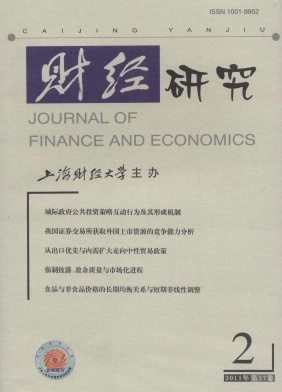突发事件情境下冗余资源与公司绩效的关系研究——以汶川地震为例
财经研究 2011 年 第 37 卷第 02 期, 页码:125 - 135
摘要
参考文献
摘要
企业常常利用冗余资源应对环境的不确定性,其原因在于冗余资源对组织环境的变化具有吸收与缓冲作用。有研究认为,组织环境变化不同,冗余资源的作用会发生改变。但是这一论断至今未得到实证检验。文章以汶川地震为背景,以四川等地的上市公司为样本,证实在突发事件情境下,沉淀冗余资源和非沉淀冗余资源均具有缓冲作用;在不同的环境变化情境下(包括变化方向和变化程度),在不同的时间窗口,不同类型的冗余资源的作用会存在差异。
[1]蒋春燕,赵曙明.组织冗余与绩效的关系:中国上市公司的时间序列实证研究[J].管理世界,2004,(5):108-115.
[2]李晓翔,刘春林.高流动性冗余资源还是低流动性冗余资源?一项关于组织冗余结构的经验研究[J].中国工业经济,2010,(7):94-103.
[3]Bourgeois L J.On the measurement of organizational slack[J].Academy of Management Review,1981,6(1):29-39.
[4]Cheng J L C,Kesner I F.Organizational slack and response to environmental shifts:Theimpact of resource allocation patterns[J].Journal of Management,1997,23(1):1-18.
[5]Cyert R,March J.A behavioral theory of the firm[M].Englewood Cliffs,NJ:Prentice-Hall,1963.
[6]Dess G G,Beard D W.Dimensions of organizational task environments[J].Administra-tive Science Quarterly,1984,29(1):52-73.
[7]Folta T B,O’Brien J.Acquisitions and firm-specific performance thresholds[EB/OL].http://people.bu.edu/Fuman/html/seminars/Fall05/Folta Seminar Paper.pdf.
[8]George G.Slack resources and the performance of privately held firms[J].Academy ofManagement Journal,2005,48(4):661-676.
[9]Greve H R.A behavioral theory of R&D expenditures and innovations:Evidence fromshipbuilding[J].Academy of Management Journal,2003,46(6):685-702.
[10]Haveman H A,Russo M V,Meyer A D.Organizational environments in flux:The im-pact of regulatory punctuations on organizational domains,CEO succession,and per-formance[J].Organization Science,2001,12(3):253-273.
[11]Iyer D N,Miller K D.Performance feedback,slack,and the timing of acquisitions[J].Academy of Management Journal,2008,51(4):808-822.
[12]Latham S,Braun M R.The performance implications of financial slack during econom-ic recession and recovery:Observations from the software industry(2001-2003)[J].Journal of Managerial Issues,2008,20(1):30-50.
[13]March J G.Interview with March,J.G.by Stanford Business School Alumni Associa-tion[J].Stanford GSB(1978-1979)1979,47(3):16-19.
[14]March J G,Shapira Z.Variable risk preferences and the focus of attention[J].Psycho-logical Review,1992,99:172-183.
[15]Miller D.The architecture of simplicity[J].Academy of Management Review,1993,18(1):116-138.
[16]Palmer T,Wiseman R.Decoupling risk taking from income stream uncertainty:A ho-listic model of risk[J].Strategic Management Journal,1999,20(11):1037-1062.
[17]Sharfman M P,Wolf G,Chase R B,Tansik D A.Antecedents of organizational slack[J].Academy of Management Review,1988,13(4):601-614.
[18]Staw B M,Sandelands L E,Dutton J E.Threat-rigidity effects in organizational be-havior:A multilevel analysis[J].Administrative Science Quarterly,1981,26(4):501-524.
[19]Tan J,Peng M.Organizational slack and firm performance during economic transi-tions:Two studies from an emerging economy[J].Strategic Management Journal,2003,24(13):1249-1264.
[20]Thompson J D.Organizations in action[M].New York:McGraw-Hill,1967.
[21]Wan W P,Yiu D W.From crisis to opportunity:Environmental jolt,corporate acquisi-tions,and firm performance[J].Strategic Management Journal,2009,30(7):791-801.
[22]Wiseman R,Catanach A.A longitudinal disaggregation of operation risk under chan-ging regulations:Evidence from the savings and loan industry[J].Academy of Manage-ment Journal,1997,40(4):799-830.
[23]Wooldridge J.Econometric analysis of cross-section and panel data[M].Cambridge,MA:MIT Press,2002.
[2]李晓翔,刘春林.高流动性冗余资源还是低流动性冗余资源?一项关于组织冗余结构的经验研究[J].中国工业经济,2010,(7):94-103.
[3]Bourgeois L J.On the measurement of organizational slack[J].Academy of Management Review,1981,6(1):29-39.
[4]Cheng J L C,Kesner I F.Organizational slack and response to environmental shifts:Theimpact of resource allocation patterns[J].Journal of Management,1997,23(1):1-18.
[5]Cyert R,March J.A behavioral theory of the firm[M].Englewood Cliffs,NJ:Prentice-Hall,1963.
[6]Dess G G,Beard D W.Dimensions of organizational task environments[J].Administra-tive Science Quarterly,1984,29(1):52-73.
[7]Folta T B,O’Brien J.Acquisitions and firm-specific performance thresholds[EB/OL].http://people.bu.edu/Fuman/html/seminars/Fall05/Folta Seminar Paper.pdf.
[8]George G.Slack resources and the performance of privately held firms[J].Academy ofManagement Journal,2005,48(4):661-676.
[9]Greve H R.A behavioral theory of R&D expenditures and innovations:Evidence fromshipbuilding[J].Academy of Management Journal,2003,46(6):685-702.
[10]Haveman H A,Russo M V,Meyer A D.Organizational environments in flux:The im-pact of regulatory punctuations on organizational domains,CEO succession,and per-formance[J].Organization Science,2001,12(3):253-273.
[11]Iyer D N,Miller K D.Performance feedback,slack,and the timing of acquisitions[J].Academy of Management Journal,2008,51(4):808-822.
[12]Latham S,Braun M R.The performance implications of financial slack during econom-ic recession and recovery:Observations from the software industry(2001-2003)[J].Journal of Managerial Issues,2008,20(1):30-50.
[13]March J G.Interview with March,J.G.by Stanford Business School Alumni Associa-tion[J].Stanford GSB(1978-1979)1979,47(3):16-19.
[14]March J G,Shapira Z.Variable risk preferences and the focus of attention[J].Psycho-logical Review,1992,99:172-183.
[15]Miller D.The architecture of simplicity[J].Academy of Management Review,1993,18(1):116-138.
[16]Palmer T,Wiseman R.Decoupling risk taking from income stream uncertainty:A ho-listic model of risk[J].Strategic Management Journal,1999,20(11):1037-1062.
[17]Sharfman M P,Wolf G,Chase R B,Tansik D A.Antecedents of organizational slack[J].Academy of Management Review,1988,13(4):601-614.
[18]Staw B M,Sandelands L E,Dutton J E.Threat-rigidity effects in organizational be-havior:A multilevel analysis[J].Administrative Science Quarterly,1981,26(4):501-524.
[19]Tan J,Peng M.Organizational slack and firm performance during economic transi-tions:Two studies from an emerging economy[J].Strategic Management Journal,2003,24(13):1249-1264.
[20]Thompson J D.Organizations in action[M].New York:McGraw-Hill,1967.
[21]Wan W P,Yiu D W.From crisis to opportunity:Environmental jolt,corporate acquisi-tions,and firm performance[J].Strategic Management Journal,2009,30(7):791-801.
[22]Wiseman R,Catanach A.A longitudinal disaggregation of operation risk under chan-ging regulations:Evidence from the savings and loan industry[J].Academy of Manage-ment Journal,1997,40(4):799-830.
[23]Wooldridge J.Econometric analysis of cross-section and panel data[M].Cambridge,MA:MIT Press,2002.
引用本文
李晓翔, 刘春林. 突发事件情境下冗余资源与公司绩效的关系研究——以汶川地震为例[J]. 财经研究, 2011, 37(2): 125–135.
导出参考文献,格式为:





 7664
7664  3695
3695

